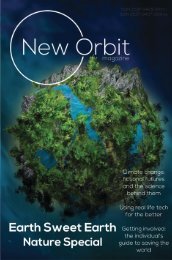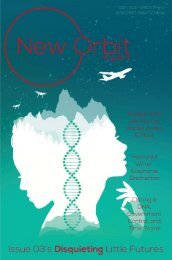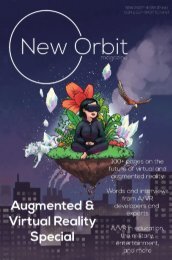New Orbit Magazine Issue 08; Feb 2020, The Future of Animals
- No tags were found...
You also want an ePaper? Increase the reach of your titles
YUMPU automatically turns print PDFs into web optimized ePapers that Google loves.
This discovery was a radical one – possibly one that could
solve our immediate plastic crisis, and save the planet from
drowning under its already extensive layer of plastic-brimming
landfills. Amazingly, though, the observation of these
waxworms was not the only example of plastic-eating
organisms that we have stumbled upon. In 2015, Stanford
University scientists reported that mealworms (the type that
you feed to pet reptiles) can turn Styrofoam into carbon
dioxide and insect droppings that may – it is as yet
inconclusive – be safe as soil for growing crops for human
consumption. A plastic-eating fungus – one of many – was
discovered colonising polyester polyurethane in a landfill in
Pakistan in 2017. In Japan, a plastic recycling dump was the
discovery site of a bacteria that has evolved to live exclusively
on plastic, that produces an enzyme that breaks plastic down into its original (organic)
components.
Tempting as it might seem to simply take this bacteria (or mealworm, or fungus) and release
it into landfills the world over, we produce and throw away plastic at such an extreme rate that
no realistic population of these organisms would be able to keep up with the supply. Instead,
if researchers are able to isolate the enzyme that the bacteria uses to transform this inorganic
material into organic (and therefore biodegradable) waste, then perhaps this can be reproduced
on a grand enough scale to reabsorb plastic waste as it is thrown away, and to empty the landfills
of the mountains of rubbish that, otherwise, could outlast the lifespan of the human race.
And this is exactly what they did. By isolating, tweaking, and redirecting the enzyme
responsible for this magical outcome, they were able to improve its efficiency by as much as 20
percent from that originally produced by the plastic-eating bacteria.
– John McGeehan, Institute of Biomedical and Biomolecular
Science, Portsmouth University










